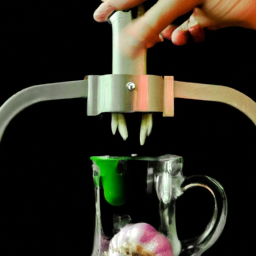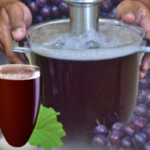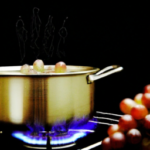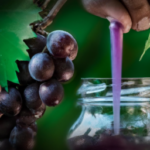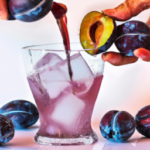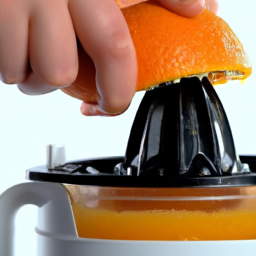On a hot summer day, when the sun is shining bright, there’s nothing quite as refreshing as a tall glass of grape juice. You don’t have to rely on store-bought options; creating your own grape juice at home with a blender is easy to do. Not only is this method budget-friendly, but it also lets you customize the flavor to suit your preferences perfectly.
Picture this: plump, juicy grapes bursting with sweetness, waiting to be transformed into a delicious drink. With just a few simple steps, you can turn those grapes into a refreshing beverage that’s perfect for any occasion.
Making grape juice with a blender is not only easy, but it’s also a great way to use up extra grapes from the farmer’s market or your own backyard. So grab your blender and let’s get started.
Key Takeaways
- Choose grapes with desired sweetness and acidity, such as Concord grapes.
- Use a high-powered blender and blend grapes in smaller batches for a smoother texture.
- Add a splash of lemon juice to enhance flavor and adjust sweetness with honey or sugar.
- Strain the mixture through a fine mesh strainer to remove pulp and store the grape juice in an airtight container in the back of the fridge to maintain freshness.
Choose Your Grapes
Grapes are a must-have ingredient when making grape juice, so grab ’em and start blending! When choosing your grapes, remember that different grape varieties have varying levels of sweetness and acidity. Some great options include Concord grapes, Muscadine grapes, and Thompson Seedless grapes.
Additionally, consider your grape color preferences. Red grapes will give your juice a deeper, richer color, while green grapes will result in a lighter, more refreshing juice.
Once you’ve decided on your grape variety and color, it’s time to move onto the next step: washing and preparing your grapes.
Wash and Prepare Your Grapes
Before I can start making grape juice, I need to properly wash and prepare my grapes. This involves removing all the stems and leaves from the grapes, as they can affect the taste and texture of the juice.
I then need to clean and rinse the grapes thoroughly to ensure that they’re free of any dirt or debris.
Removing Stems and Leaves
First, you’ll wanna grab your bunch of grapes and pick off any stubborn stems or leaves that are still attached. This step is crucial to ensure that your grape juice will have a smooth and consistent texture. Here are some tips to make this process easier:
- Hold the grape bunches under running water to help loosen the stems and leaves.
- Use a sharp knife or scissors to cut off the stems close to the grapes.
- Gently rub the grapes between your fingers to loosen any remaining leaves.
- If you’re using small grapes, you can also try squeezing them gently to remove the stems.
Don’t worry about removing every single stem or leaf, but try to get rid of the majority to avoid any bitter taste in your juice.
Now that you have removed the stems and leaves, it’s time to move on to the next step of the process: cleaning and rinsing the grapes. This step is crucial to remove any dirt, debris, or pesticides that may be present on the surface of the grapes.
Cleaning and Rinsing
Ironically, the key to a healthy and delicious grape juice isn’t the grapes themselves, but rather the cleaning and rinsing process.
Before putting the grapes in the blender, it’s important to clean them thoroughly to remove any dirt, pesticides, or bacteria that may be present. One of the best ways to do this is by using natural cleaning products such as vinegar or baking soda. These products are effective in removing any harmful substances without leaving any residue on the grapes.
When rinsing the grapes, it’s important to take extra precautions to avoid bacterial contamination. One tip is to rinse them under running water for at least 30 seconds, making sure to rub each grape gently to remove any dirt or debris. Another tip is to use a colander or strainer to rinse the grapes, as this will help to remove any excess water and prevent the grapes from becoming waterlogged.
By taking these steps, you can ensure that your grape juice is not only delicious but also safe to drink.
With the grapes cleaned and rinsed, it’s time to add them to the blender and start blending!
Add Grapes to Blender
Now, toss a generous amount of grapes into your blender and get ready to taste the sweet, juicy goodness! But before adding the grapes, make sure your blender is suitable for this task. High-powered blenders, such as Vitamix or Ninja, work best for making grape juice. If you don’t have a high-powered blender, you can still make juice, but the consistency may be a bit chunkier.
When it comes to grape varieties, any type can be used to make juice. However, Concord grapes are the most commonly used for juice because of their intense flavor and high sugar content. Red and green grapes can also be used, but they may produce a lighter-colored juice.
Once the grapes are in the blender, you’re ready to move on to the next step of blending them into a smooth liquid.
Blend Grapes
To achieve a smoother texture, it’s advisable to blend the grapes in smaller batches. Blending techniques play a crucial role in ensuring that the grape juice is smooth and free of lumps. When blending, it’s important not to overload the blender with too many grapes at once.
Start by adding a few grapes, then gradually increase the amount until all the grapes are blended. Here are some tips to make your blending experience more enjoyable:
- Use ripe grapes for a sweeter taste
- Add a splash of lemon juice to enhance the flavor
- Experiment with different grape juice recipes to find your favorite combination
By following these tips, you’ll be able to create a delicious and refreshing grape juice that’s perfect for any occasion. Once the grapes are blended to your desired consistency, the next step is to strain the grape mixture.
Strain Grape Mixture
To strain the grape mixture, I first choose a fine mesh strainer that’ll effectively remove the pulp and keep the juice. I prefer using this type of strainer. Once I have my strainer ready, I pour the grape mixture through it. Then, I press down on the pulp with a spoon or spatula to extract as much juice as possible.
Make sure to leave a double new line after every complete sentence.
Choosing a Strainer
After blending the grapes, it’s important to choose a strainer that will effectively remove any unwanted seeds or pulp from the juice. Here are some things to consider when selecting a strainer:
-
Types of strainers: There are several types of strainers available, including mesh strainers, cheesecloth, and nut milk bags. Mesh strainers come in different sizes and can be made of plastic or metal. Cheesecloth is a thin, cotton fabric that is available in different grades. Nut milk bags are made of a fine mesh material and are designed for straining nut milk, but can also be used for juicing.
-
Pros and cons of different strainer materials: Mesh strainers made of plastic are affordable and easy to clean, but may not be as durable as metal ones. Metal strainers are more durable but can be more expensive. Cheesecloth is inexpensive and versatile but can be difficult to clean. Nut milk bags are easy to clean and reusable, but may not be as effective at removing pulp as other types of strainers.
-
Personal preference: Ultimately, the type of strainer you choose will depend on your personal preference and the amount of time you want to spend straining the juice. Experiment with different types of strainers to find the one that works best for you.
Choosing the right strainer is an important step in making grape juice with a blender. Once you’ve selected the strainer that works best for you, it’s time to move on to the next step: straining the grape pulp.
Straining Grape Pulp
Now that we’ve chosen a suitable strainer, it’s time to move onto the next step in making grape juice with a blender. We need to strain the grape pulp from the juice.
To do this, we’ll need to pour the blended grapes through the strainer and use a spatula or spoon to press the pulp against the mesh to extract as much juice as possible.
After straining the grape pulp, you may be left wondering what to do with it. Don’t throw it away just yet! There are many uses for grape pulp, such as making jams, jellies, and even grape pulp recipes like grape muffins or grape bread. The pulp is also rich in fiber and antioxidants, making it a healthy addition to any recipe. So, before discarding the pulp, consider using it in one of these creative ways.
Now that we’ve strained the grape pulp, we can move on to the final step in making grape juice – sweetening it to taste.
Sweeten to Taste
Adjusting the sweetness of your grape juice is a matter of personal preference. Some people like their juice tangy and tart, while others prefer it sweeter. To sweeten your grape juice, you can add honey or sugar. Here are some tips for getting the perfect sweetness:
-
Start small: When adding sweeteners to your grape juice, it’s best to start with a small amount and taste as you go. You can always add more, but it’s difficult to take away sweetness once it’s been added.
-
Use alternative sweeteners: If you’re looking for a healthier alternative to sugar, try using honey, maple syrup, or agave nectar. These sweeteners are more natural and have a lower glycemic index than white sugar.
-
Consider the type of grapes: Some grapes are naturally sweeter than others. If you’re using very sweet grapes, you may not need to add any additional sweeteners.
Once you’ve adjusted the sweetness of your grape juice to your liking, it’s time to chill it.
Chill Your Grape Juice
Now that I’ve made grape juice with my blender, it’s time to chill it. Refrigerating the juice is essential to keep it fresh for longer periods.
I usually pour the juice into a glass jar and place it in the refrigerator for a couple of hours before drinking. If I want my juice extra cold, I’ll add some ice cubes before drinking.
Refrigerating Your Juice
After blending your grapes, it’s important to refrigerate your juice to maintain its freshness and taste. Here are some tips for storing fresh juice in your refrigerator:
- Store your grape juice in an airtight container to prevent it from absorbing any odors from other foods in your fridge.
- Keep your grape juice in the back of the fridge where it’s the coldest, away from the door where temperature fluctuations can occur.
Homemade grape juice can last up to 5 days in the refrigerator, but it’s best to consume it within 2-3 days for optimal freshness. If you notice any signs of spoilage, such as a foul odor or mold, discard the juice immediately.
Before drinking your grape juice, give it a good shake or stir to evenly distribute any sediment that may have settled at the bottom of the container.
Now that your grape juice is chilled and ready to go, it’s time to add some ice for a refreshing summer drink.
Adding Ice
To cool down your summer beverage, simply plop a few ice cubes into your glass and watch as the heat melts away like a popsicle on a hot July day. But if you want to take your grape juice to the next level, consider adding some blended ice.
Blending ice cubes into your grape juice not only cools it down, but it also adds a slushy texture that can make you feel like you’re sipping on a fancy frozen drink. When blending ice into your grape juice, it’s important to use the right blending techniques.
Start by adding a few ice cubes to your blender and pulsing it a few times until the ice is chopped up into small pieces. Then, gradually add in your grape juice and blend until the ice is fully incorporated. If you want to get creative, you can also try adding in alternative ingredients like frozen berries or sliced bananas for a fruity twist.
Once your blended grape juice is ready, serve and enjoy!
Serve and Enjoy
Once the grape juice is ready, simply pour it into glasses and savor the refreshing taste. To enhance the experience, consider some creative serving ideas and pairings with food. For instance, you can add a slice of lime or lemon to the glass to give the juice a citrusy twist. Alternatively, you can mix the grape juice with other fruit juices such as orange or pineapple for a more complex flavor profile.
When it comes to pairing grape juice with food, the options are endless. You can serve it with cheese, crackers, and charcuterie for a sophisticated appetizer. Or, you can pair it with a light salad or seafood dish for a healthy and refreshing meal. Whatever your choice, make sure to enjoy the grape juice in good company and in a relaxing environment.
To store your grape juice, follow the next subtopic on how to keep it fresh for longer periods.
Store Your Grape Juice
Now that you’ve enjoyed your freshly made grape juice, it’s time to think about how to store the remaining juice. Proper storage is important to preserve the freshness and taste of the juice for a longer period. Here are some tips and preservation techniques to help you store your grape juice:
-
Refrigerate: Store the grape juice in the refrigerator immediately after making it. Keeping it at a temperature between 32-40°F will help to maintain its freshness and quality for up to 5-7 days.
-
Use airtight containers: Transfer the grape juice to an airtight container or bottle before storing it in the refrigerator. This will prevent the juice from oxidizing and losing its flavor.
-
Freeze: If you’re not planning to consume the grape juice within a week, you can freeze it for up to 6 months. Pour the juice into freezer-safe containers or ice cube trays and place them in the freezer.
By following these storing tips and preservation techniques, you can enjoy your homemade grape juice for a longer period. Now that you know how to store your grape juice, let’s move on to the next section where we’ll discuss how to experiment with flavors to create unique and delicious blends.
Experiment with Flavors
Don’t be afraid to mix things up and try new flavors when creating your own unique blends of juice. One of the best things about making grape juice with a blender is that you can experiment with different flavor combinations until you find the perfect one.
For example, you can add a splash of lemon juice to your grape juice to give it a tangy twist. Alternatively, you can add a few sprigs of fresh mint to give your juice a refreshing herbal flavor.
Once you’ve created your own flavor combinations, it’s important to do some taste testing to make sure your juice is just right. Take a small sip of your juice and pay attention to the flavor profile. Is it too sweet? Too tart? Too bitter? Adjust the flavors as needed until you achieve the perfect balance.
With a little bit of experimentation and taste testing, you can create your own unique and delicious grape juice blends that you’ll love to drink again and again.
Frequently Asked Questions
Can I use frozen grapes for grape juice?
Yes, frozen grapes can be used for grape juice. Benefits include convenience and longer preservation. However, drawbacks include a less fresh taste and altered texture. Consider using alternative fruits for homemade juice, such as strawberries or blueberries.
How long does it take to blend the grapes into juice?
Blending time for grape juice varies based on grape quality and desired consistency. Fresh, ripe grapes will blend faster than frozen or less ripe grapes. Expect blending to take 1-2 minutes.
Do I need to remove the stems from the grapes before blending them?
Yes, it’s best to remove the stems from the grapes before blending them. Leaving the stems on can result in a bitter taste in the juice. To remove stems, use a sharp knife or grape stemmer.
What is the best type of blender to use for making grape juice?
The best blender types for making grape juice are high-powered blenders with a minimum of 1000 watts. A powerful motor ensures that the grapes are well blended and the juice is smooth.
Can I use honey or another sweetener instead of sugar to sweeten my grape juice?
When making grape juice, honey can be used as a nutritive sweetener instead of sugar. Non-nutritive sweeteners may also be used, but the taste may be affected. Experiment with different sweeteners to find what works best for your taste preference.
Conclusion
In conclusion, making grape juice with a blender is an easy and delicious way to enjoy the many health benefits of grapes. Whether you prefer sweet or tart grapes, you can choose any variety you like to create a refreshing and nutritious drink.
Remember to wash and prepare your grapes before blending, and strain the mixture to remove any pulp or seeds. You can also experiment with different flavors, such as adding lemon or mint for a unique twist.
One example of the benefits of grape juice is a study conducted by the University of Leeds, which found that consuming grape juice can lower blood pressure and reduce the risk of heart disease. This highlights the importance of incorporating grape juice into your diet as part of a healthy lifestyle.
By making your own grape juice with a blender, you can control the ingredients and ensure that you’re getting the maximum health benefits from this delicious drink. So go ahead and give it a try – your taste buds and your body will thank you!
Ilana has been a vegan for over 10 years. She originally made the switch for health reasons, but soon found herself becoming more and more passionate about the ethical and environmental implications of a vegan lifestyle. Ilana is the author of The Graceful Kitchen, a blog all about veganism. She loves to cook up delicious and nutritious vegan meals, and share her recipes with others who are interested in leading a cruelty-free life. Ilana is also a strong advocate for using whole foods as the foundation of a healthy diet, and believes that going vegan is one of the best ways to achieve this.

